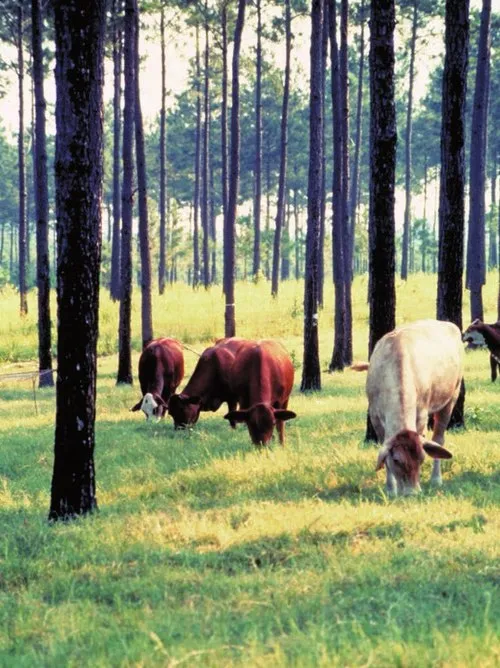silvopasture!!!
Silvopasture!
I had never heard this term before. But in my climate science class, last lecture, my professor defined it as a system of agriculture whereby trees and livestock live together, with the trees providing shade for cattle and the livestock providing fertilizer for the trees. This symbiotic system of agriculture was listed as the 11th-most effective means of sequestering carbon, according to a policy group which in 2017 tested every means of climate action to measure their efficacy.

Silvopasture.
It's a beautiful word. And a beautiful idea. I called my grandfather, who has a PhD in animal research and has spent his entire career studying the best ways to raise cattle "to make beef taste good." He had never heard this word, but when I described it he told me that this was the exact technique used by a cattle operation in Uruguay that he had visited — the largest cattle operation in South America, which uses eucalyptus trees to shade its cows. (Shade, and the protection from heat stress that it offers, are incredibly important to protect cows' health and lifespans in warm areas. Cows that are under stress also produce poor-quality beef, which is why my grandfather always says the best way to raise a cow is to make sure it's happy.)
Silvopasture has been widely practiced all over the globe; not just in South America but in Iran and also, historically, in European woodlands from the ancient forests of England and Wales to the dehesas, or oak-shaded pastures/cropland, of Spain.
I love this idea that a more pastoral world, one that takes after traditional means of agriculture instead of devaluing it, could be the key to guarding against the threats of climate change. Turning to the rural past, searching its hard-won wisdom, to protect our collective future.
We need to pay more attention to things like this. Low-tech solutions to climate change. We need to abandon the idea that the world can only be saved by hoodie-clad twentysomethings in Silicon Valley who have been given more venture capital than they know what to do with. Silicon Valley is the world in which the current figurehead of American fascism rose to power.1 We cannot just sit and wait for the invention of some new tech, some overhyped gizmo, whose creators will suffer no consequences if it fails to deliver because their startup has already been acquired.
Many of the most effective means of carbon reduction that this institute named are actually pretty easy to implement. The single most effective one, which could reduce up to 102 gigatons of carbon dioxide-equivalent from 2020-2050 if implemented, was reducing food waste. Number four on the list was fixing the cooling systems of industrial and commercial buildings. Because leaky or outdated pipes, in need of simple maintenance or repair, are pouring gigatons of fluorinated greenhouse gases into the environment, and something as simple as stopping up the leaks could store 57.15 tons of CO2-equivalent greenhouse gases.
And silvopasture sequesters more than twice as much carbon as electric cars :)
Some more very practical, easy-to-implement highlights: better insulation for buildings and homes (which would save energy from being spent on heating) was the 16th-most effective strategy, sequestering 15.3-18.54 gigatons of CO2-equivalent. LED lighting was number 18. Onshore wind was number 6 (at 47.9 to 143.56 gigatons), solar (both utility-scale and [distributed[(tab:https://drawdown.org/solutions/distributed-solar-photovoltaics) (i.e. on people's houses)) occupied places 8 and 10, at 40.8-11.6 and 26.65-64.86 gigatons respectively. Offshore wind was in 26th place.
Indigenous peoples' forest rights could sequester between 8.7 and 12.51 gigatons of CO2. What this would mean is — rather than giving ownership of land to an eco-friendly organization to protect it — handing it back to the people that had historically lived on that land for thousands of years. Because they typically know how to take better care of it. (Cost: $0.)
I think we all know which self-obsessed, Mars-obsessed, lies-about-everything, buys-a-perfectly-good-social-media-platform-and-turns-it-into-a-shitstorm-of-misinformation-so-his-buddy-can-win-an-election-and-appoint-him-head-of-a-made-up-government-agency-named-after-a-meme billionaire I'm talking about here.↩